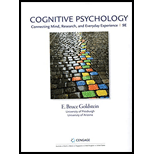
Introduction
Short-term memory (STM) involves storing information for a limited period of time, while long-term memory (LTM) involves storing experiences and information for long periods of time. Coding refers to the way in which the stimulus or information is represented in the mind. This can be visual (in the form of patterns or images), auditory (in the form of sound), or semantic (in terms of its meaning).
Explanation of Solution
Answer and explanation
Any information or experience that is represented in images or patterns in short-term or long-term memory is visually coded. Visual coding in STM is demonstrated by an individual recalling a pattern they just observed, while visual coding in LTM is when an individual remembers or visualizes a familiar face or place.
Auditory coding involves information being stored in the form of sound. In STM, it is demonstrated by an individual repeating a phone number over and over again to remember it. An example of auditory coding in LTM is when a person plays a song in their head.
Lastly, semantic coding involves storing information in terms of its meaning. Semantic coding in STM is exemplified by an individual categorizing words into groups. In LTM, recalling the meaning of the lyrics of a song or the general meaning of the plot of a novel demonstrates semantic coding.
Want to see more full solutions like this?
Chapter 6 Solutions
COGNITIVE PSYCHOLOGY - WITH MINDTAP
- Write a 1,200-1,500-word analysis that describes the characteristics and roles you hope to embody as a counselor and the counselor dispositions that you want to bring with you. You may write in the first person for this assignment. Include the following in your analysis: Your role as a clinical mental health counselor or school counselor in the agency, school, and/or community you serve. Include strategies for collaborating and consulting with behavioral health care professionals. Refer to the importance of certification and licensure related to your role and professional identity. Strategies to develop a counselor identity that fosters leadership, advocacy and provides services as a licensed professional counselor or school counselor for persons with mental health issues. Depending on your program of study, refer to the GCU "SC Professional Dispositions of Learners" or the GCU "Counselor Dispositions" located in the Class Resources when completing this assignment. Consider your…arrow_forwardwhat makes yoruba different from other religions or culturesarrow_forwardWhat does the PIC/NIC Analysis focus on from the Performer's Perspective? Consequences Antecedents Behavior X Behavior Yarrow_forward
- What does the PIC/NIC Analysis focus on from the Performer's Perspective? Consequences Antecedents Behavior X Behavior Yarrow_forwardThe Performance Diagnostic Checklist-Human Services (PDC-HS) is an assessment tool to identify areas of improvement for employee performance within a work environment. For this task, you can complete the PDC-HS as a self-assessment within your work requirements or you can interview a colleague. Describe the performance concernarrow_forwardWhat are three methods for dissemination of information that school counselors can use after watching the YouTube video titled: “Self-care for school counselors” (https://www.youtube.com/watch?v=hvQyjEh1Lmk) by CSCA Executive Director (2020, April 2)? Please write in a narrative format and include citations and references.arrow_forward
- What are the three most relevant principles school counselors need to be aware of watching the YouTube video titled: “Self-care for school counselors” (https://www.youtube.com/watch?v=hvQyjEh1Lmk) by CSCA Executive Director (2020, April 2))? Please write in a narrative format and include citations and references.arrow_forwardWhat are three interventions or programs school counselors can implement in schools after watching the YouTube video titled: “Self-care for school counselors” (https://www.youtube.com/watch?v=hvQyjEh1Lmk) by CSCA Executive Director (2020, April 2))? Please write in a narrative format and include citations and references.arrow_forwardWhat are three professional best practices that school counselors can implement or can recommend in schools after watching the YouTube video titled: “Self-care for school counselors” (https://www.youtube.com/watch?v=hvQyjEh1Lmk) by CSCA Executive Director (2020, April 2))? Please write in a narrative format and include citations and references.arrow_forward
- What are three strategies school counselors use in schools after watching the YouTube video titled: “Self-care for school counselors” (https://www.youtube.com/watch?v=hvQyjEh1Lmk) by CSCA Executive Director (2020, April 2)? Please write in a narrative format and include citations and references.arrow_forwardWhat are three most important knowledge a school counselor can gain from watching the YouTube video titled: “Self-care for school counselors” (https://www.youtube.com/watch?v=hvQyjEh1Lmk) by CSCA Executive Director (2020, April 2))? Please write in a narrative format and include citations and references.arrow_forwardDraft your PowerPoint Outline for Chapter 12. Toward Behavior Analytic Practice in Augmentative and Alternative Communication (AAC) in Roane, H.S., Ringdahl, J.E., & Falcomata, T.S. (Eds.). (2015). Clinical and organizational applications of Applied Behavior Analysis. Develop sections based on chapter summary EDSE 624 - Applied Behavior Analysis: Applications Discussion Leader Presentation Assignment Instructions Embed objectives in beginning Include 2-3 student objectives related to the chapter content Include 1-2 BACB Task List items that best match the content Embed main message in the middle and end Add Visuals Keep your visuals structures, simple and clear Select a consistent theme, color scheme, etc. Create header slides from outline and add additional content slides under each Paste in detailed outline information, then edit text to simple bullets or images Limit distracting stimuli (e.g. organization branding, distracting animations) Ensure visuals are clear from the…arrow_forward
 Ciccarelli: Psychology_5 (5th Edition)PsychologyISBN:9780134477961Author:Saundra K. Ciccarelli, J. Noland WhitePublisher:PEARSON
Ciccarelli: Psychology_5 (5th Edition)PsychologyISBN:9780134477961Author:Saundra K. Ciccarelli, J. Noland WhitePublisher:PEARSON Cognitive PsychologyPsychologyISBN:9781337408271Author:Goldstein, E. Bruce.Publisher:Cengage Learning,
Cognitive PsychologyPsychologyISBN:9781337408271Author:Goldstein, E. Bruce.Publisher:Cengage Learning, Introduction to Psychology: Gateways to Mind and ...PsychologyISBN:9781337565691Author:Dennis Coon, John O. Mitterer, Tanya S. MartiniPublisher:Cengage Learning
Introduction to Psychology: Gateways to Mind and ...PsychologyISBN:9781337565691Author:Dennis Coon, John O. Mitterer, Tanya S. MartiniPublisher:Cengage Learning Psychology in Your Life (Second Edition)PsychologyISBN:9780393265156Author:Sarah Grison, Michael GazzanigaPublisher:W. W. Norton & Company
Psychology in Your Life (Second Edition)PsychologyISBN:9780393265156Author:Sarah Grison, Michael GazzanigaPublisher:W. W. Norton & Company Cognitive Psychology: Connecting Mind, Research a...PsychologyISBN:9781285763880Author:E. Bruce GoldsteinPublisher:Cengage Learning
Cognitive Psychology: Connecting Mind, Research a...PsychologyISBN:9781285763880Author:E. Bruce GoldsteinPublisher:Cengage Learning Theories of Personality (MindTap Course List)PsychologyISBN:9781305652958Author:Duane P. Schultz, Sydney Ellen SchultzPublisher:Cengage Learning
Theories of Personality (MindTap Course List)PsychologyISBN:9781305652958Author:Duane P. Schultz, Sydney Ellen SchultzPublisher:Cengage Learning





